What Animals In The Tundra Eat Bearberry
Animals of the Tundra
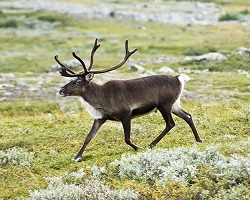
Animals of the tundra, similar this caribou, are well adapted to the cold and dry out weather. Click for more than particular.
Could you handle ever living in the common cold? Some animals can. Animals of all sizes have adapted to harsh weather conditions and long winters of the tundra.
Many animals accept shorter legs and ears to minimize exposing their skin to the cold. Some are also well adjusted to living loftier up in the mountains. For case, mammals at high elevation are able to use oxygen more than efficiently.
Small creatures, such as ground squirrels, tin can seek refuge in vegetation but because it's usually sparse and low, it may expose them to predators. To avoid danger, some species accept evolved to be fast runners or to be camouflaged.
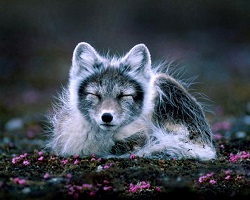
The mixed fur colors of this arctic play a joke on show the white wintertime coat giving way to the nighttime summer coat. Click for more particular.
Between summertime and winter, the grayish-brown fur of snowshoe hare, arctic fox, and others like them blends into white hairs in preparation for winter camouflage.
Sometimes casualty animals feed at night to avert being eaten. They may besides reproduce a lot since non all young volition survive to adulthood.
Fat = Energy?
Some other cardinal to an brute's survival in the tundra is knowing when to swallow and when to slumber in order to salvage energy. Many animals in the tundra hibernate during the long, cold winter months.
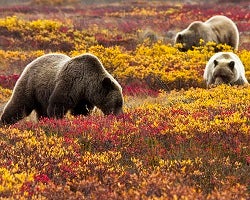
Grizzly bears brand certain to get enough food during the warm seasons on the tundra so they can hibernate through the colder winter months. Image by Albert Herring.
Hibernation is a menses of rest lasting several months. During this time, animals stay hidden in dens. Their metabolisms lower into a dormant state, so less energy is required for their bodies to perform the necessary functions. For that free energy, they rely on stores of fat they congenital upwardly over the summer.
Tundra animals accept other strategies to proceed warm too. It helps to have a lot of fur and fatty. After all, the colder it is, the more energy it takes for a mammal to maintain a stable body temperature to live.
Merely like in other biomes, in the tundra, different types of animals get energy from different types of foods. Carnivores are at the top of the food spider web considering they are meat eaters.

This crabeater seal lives on the coast of Antarctica. Information technology can store fat hands, building a thick blab to protect information technology from the common cold. Image by François Guerraz.
Carnivorous mammals such as wolves and seals prey on smaller animals to survive while herbivorous mammals but swallow plant-based foods. Animals that swallow both other animals and plants are called omnivores.
Lemmings, voles, caribou, arctic hares and squirrels are examples of tundra herbivores at the bottom of the nutrient web. They ofttimes have a potent sense of smell to help them notice food underneath the snow.
Timing is Everything
Summertime melts abroad the snow, assuasive shallow wetlands to form. In the available pools of water, insects breed and concenter birds. This explains why animals are nearly active in the short summer. They forage heavily on the plentiful insects and flowers that are in bloom before they are forced to hide or migrate to a warmer place for winter. Luckily, during the long-lighted days of summertime, there is more fourth dimension in each 24-hour interval to hunt for food.
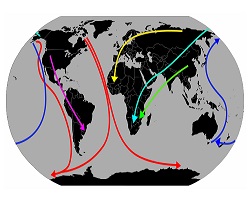
This map shows migration routes taken past several birds, including some that alive in the tundra. Click for more detail.
Summer is for mating, also. Everything from insects, like mosquitoes, flies, moths, grasshoppers, blackflies and arctic bumble bees, to larger animals take advantage. It turns into a race against time.
Migratory birds such as falcons, loons, sandpipers, terns and snow birds must successfully produce young during the short summer. If they don't, there is not enough fourth dimension to starting time over with a second nest.
Fifty-fifty given constraints like these, a lot of animals call the tundra home for at to the lowest degree part of the twelvemonth. As the seasons change, then do the species found in the tundra.
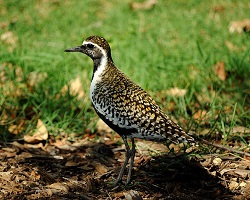
Pacific aureate plover spend office of the year in the Alaskan tundra, and part in South America. Image by Daniel Ramirez.
Young plover, a kind of bird, are abased on the tundra in Alaska and have to make their way back to Argentina in South America on their own. The adult parents go out earlier, perchance to allow more food for the young.
Stories similar the plovers' are normal for species that spend part of the time in the tundra.
Insect Anti-Freeze
Moving-picture show holding an insect in your hand and how tiny information technology looks compared to you and everything else. Even small insects live in the tundra. Merely how exercise they survive in below-freezing temperatures? For some, the answer is antifreeze.
If you've heard of antifreeze, it was probably from someone with a automobile. In cars, antifreeze is a manmade (and very dangerous) chemical mixture that allows all the water-based liquids to operate in a broad range of low and loftier temperatures.

All the tiny dots in this movie are mosquitoes. But how do mosquitoes live in the cold weather condition of the tundra? Click for more particular.
Just like it's of import for a machine to function, antifreeze in tundra insects is critical for life. Insect antifreeze is a naturally occurring poly peptide that lowers the freezing betoken of water in insect bodies.
The protein'south construction besides lets it attach to ice crystals to prevent more from forming. Non merely do insects benefit from this accommodation, but arctic fish do as well.
The cold can bear on insects in other means, as some insects mature very slowly, perhaps taking 10 to 15 years to pass through all their larval stages. This slow growth occurs because they can only become a little food each brusk summer. No matter the size of the animal, life in the tundra tin be tough.
Images via Wikimedia eatables. Woolly bear image via IronChris.
Source: https://askabiologist.asu.edu/animals-tundra
Posted by: quinnpase1945.blogspot.com


0 Response to "What Animals In The Tundra Eat Bearberry"
Post a Comment